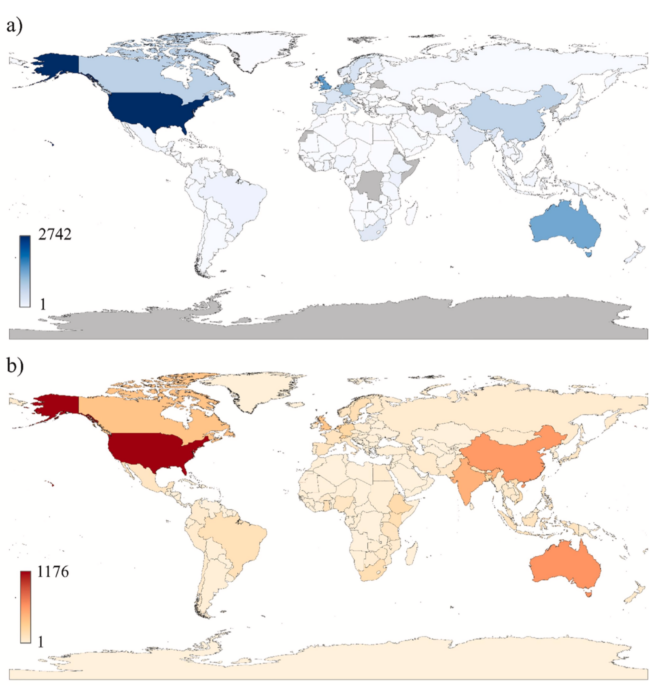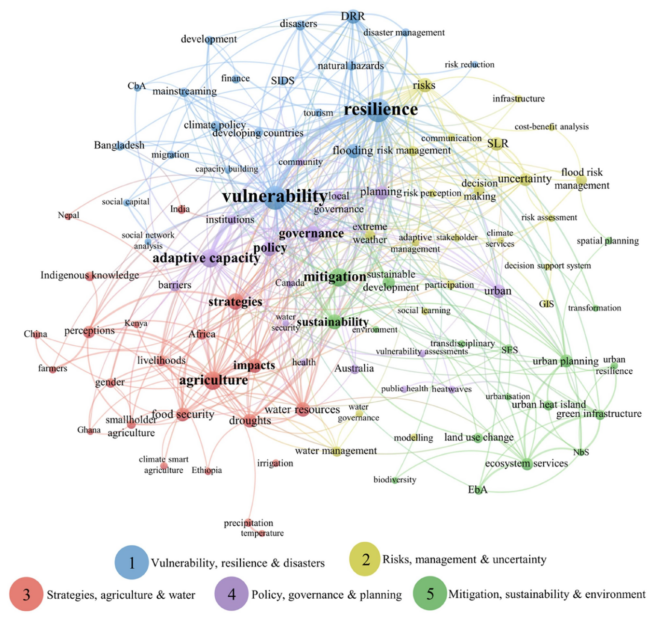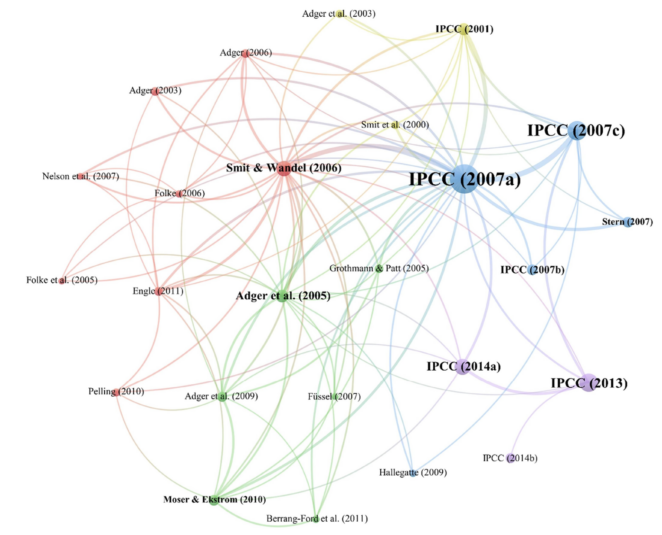Mapping the Evolution and Current Trends in Climate Change Adaptation Science

Introduction
Research on climate change adaptation has increased in number and significance since its origin in the 1970s. Yet, the volume of information on adaptation is now difficult to manage given its vast scope and spread across journals, institutions, disciplines and themes. Large bodies of work exist that, even if not explicitly framed as climate change adaptation, still form a critical mass of knowledge that supports climate change adaptation ideas, theoretical development and implementation.
This paper fills this gap by providing a bibliometric review of the main trends in peer-reviewed literature that specifically focus on the human dimensions of climate change adaptation. It demonstrates the evolution of climate adaptation science, how the research topics have changed over time, the social networks of authors via co-authorship, and the most cited papers and the foundational literature that underpins the climate adaptation science literature.
This weADAPT article is an abridged version of the original text, which can be downloaded from the right-hand column. Please access the original text for more detail, research purposes, full references, or to quote text.
Methods and Tools
The study employs a combination of bibliometric, visualisation and content analysis techniques to analyse the climate change adaptation literature. Bibliometrics is a method that uses statistical analysis of publication metadata, and is therefore able to assess much larger literature sets than narrative, systematic or meta-analyses methods of reviewing literature.
A set of parameters was used to search, include, and exclude publications from articles, reviews, book chapters and books. These parameters aimed to select publications where authors have prioritised climate change adaptation as a core focus of their publication, based on the terms used by authors in titles, abstracts, and key words.
The inclusion search criteria included variations of terms to related to climate change adaptation (e.g. ‘climat* chang* adapt*’). Irrelevant publications that lacked a societal dimension were iteratively filtered out by adding exclusion terms to the query (e.g. physiology, phenology, genes, genetic).
The search revealed 10,274 publications from Scopus, and 8,856 from Web of Science Core Collection. Duplicates were removed, and a further 284 publications were screened out following review of their abstracts, keywords, and titles, such that the final database contained a total of 11,506 publications.
Outcomes and Impacts
Core subject areas, Journals and Authors
The main subject areas that publications covered, based on the Web of Science categories, were ‘environmental sciences’, ‘environmental studies’, ‘meteorology and atmospheric sciences’ and ‘water resources’. The journals that have contributed the most to this literature include Climatic Change (2.7%), Sustainability (2%), Climate and Development (2%), Environment Science and Policy (2%), and Regional Environmental Change (1.9%).
The five main countries that researchers were affiliated with were the United States (23.8% of publications), the UK (13.3%), Australia (12.1%), Germany (9.1%) and Canada (7.2%). Beyond these countries, research on climate change adaptation has been published by an additional 169 countries. See a) in figure below for a visual representation of the global distribution of author affiliations.

The most published authors of this literature were J.D. Ford, R.J.T. Klein, and S. Juhola. However, most authors (76.1%) were not specialists on the topic, having only authored one publication. When analysing co-authorship links among leading authors with at least 10 publications and 500 citations, several distinct collaborative clusters emerged. Co-authorships show clear patterns of relatively tight collaboration relationships but also lack of cross-cluster collaboration. While such tight clustering is very typical in emerging knowledge domains, this can reduce innovation if authors do not expose their ideas to diverse views by working across domains.
Temporal evolution of research
The first recorded publication from this literature was published in 1978 and assessed the relationship between climatic variations and horticultural trade flows in Europe. Overall, this literature has seen an average annual growth rate of 28.5%, and thus is set to double in size by early 2022. Since 2010 there has been a rapid increase in research, with 4035 publications (35.1%) over the five years in the emerging period (2010-2015) and a further 6,283 publications (54.6%) in the latest five years (2016-2020).
In addition, the diversity of subject areas covered by this literature has expanded considerably over time. The first publications from this literature focused on ‘economics’, ‘meteorology and atmospheric sciences’ and ‘multidisciplinary agriculture’, but ‘environmental sciences’ and ‘environmental studies’ have become dominant subject areas more recently. The focus of research began to diversify from natural sciences to better encompass human dimensions such as ‘regional and urban planning’, ‘development studies’ and ‘geography’ from 2005 onwards, and most recently, ‘green and sustainable science and technology’ has become a key research area.
Core research topics and themes
The most cited publication of this literature cover topics such as food security, adaptive capacity, health impacts, climatic extremes, social capital, and limits and barriers to adaptation.
Five predominant themes became apparent when common co-occuring keywords were mapped:
- The concept of vulnerability to climate change, which is often researched in conjunction with resilience to climate change, and how this relates to natural hazards such as flooding.
- Assessment of risks, risk management, and decision-making, and how uncertainty factors into these processes.
- Climate change adaptation in agriculture, as well as strategies to adapt to climate change. There has also been considerable focus on the perceptions of farmers, as well as food security as climate changes, resulting in more severe and frequent droughts and a need to assess the use of water resources.
- Research on policy, governance, and aspects of planning.
- Mitigation and sustainability research, such as how urban planning and sustainable development can alleviate the impacts of climate change. There has also been considerable focus on ecosystem services, which are strongly linked to conserving biodiversity, and how these services may be maintained in a changing climate through ecosystem-based adaptation, nature-based solutions and green infrastructure.

Literature foundations
Analysing the cited reference lists of the publications provides valuable insights into how the field of climate change adaptation has been shaped, by distinguishing key journals that produce the underlying knowledge base, as well as the leading publications underpinning this literature.
Analysis found that the most influential publications were produced by the IPCC, with the 2007 report on impacts, adaptation and vulnerability cited by almost 16% of the literature. The next four most cited publications were also IPCC publications, demonstrating the importance of these thorough and accessible international reviews. Smit and Wandel’s (2006) seminal work on assessing adaptation, adaptive capacity and vulnerability was also a central publication to the development of this literature (767 citations, 6.7%). Similarly, Adger et al. (2005) was broadly co-cited with publications that focused on successful adaptation across scales (600 citations; 5.2%) as well as Stern (2007) (463 citations; 4%) that focused on the economics of climate change, and Moser and Ekstrom (2010) (454l 3.9%) which concerns barriers to climate change adaptation.

Cautions and limitations in reviewing adaptation literature
Even though bibliometric methods enable analysis of large quantities of data, the results of this paper must be treated with some caution. For example, geographical biases are embedded in the databases reporting structures that can impact on, for instance, geographical representation of authors and institutions. In addition, the study was not able to analyse factors such as author gender, given that this information is not part of the general publication submission process and hence does not allow for easy trend generation from databases. The authors of this paper also recognise that focusing only on peer-reviewed climate adaptation literature leaves out vast amount of knowledge from grey literature.
Conclusions and Future Directions
The subject of climate change adaptation is now truly global in its reach given its mainstreaming across journals, sectors and disciplines combined with rapid annual growth rate that is set to continue. The key topics have clearly diversified over time with new topics such as ecosystem-based adaptation and green infrastructure in particular in the last five years.
Yet, despite this diversification and mainstreaming of climate adaptation science, the literature is still heavily dominated by developed countries. This leads to a pressing need to increase especially developing country contributions to this vast literature so that it adequately reflects the diversity of climate adaptation insights and experiences.
Future research could also look into similar trends in grey literature and its rich contributions. This will strengthen insights on how climate adaptation research has evolved and identify future directions on emerging trends that are relevant to adaptation science, policy and practice. This could be done via methods such as more extensive use of machine learning that can handle even larger datasets.
Suggested citation:
Nalau, J., & Verrall, B. (2021). Mapping the evolution and current trends in climate change adaptation science. Climate Risk Management, 32.https://doi.org/10.1016/j.crm.2021.100290
Related articles:
- Visualizing connections: Mapping the landscape of adaptation research and practice through weADAPT
- Meeting the Needs, Keeping the Balance: Review of climate change adaptation tools and methods
- Framework for needs-informed research: assessing climate processes
- Using climate information to support adaptation planning and policy-making: A practical case study in Bagamoyo District, coastal Tanzania.
(0) Comments
There is no content